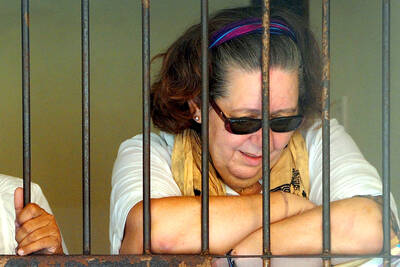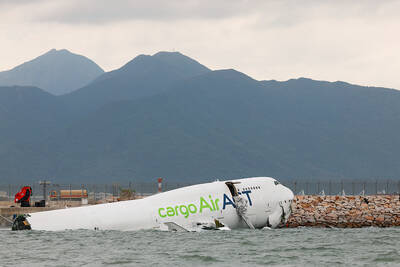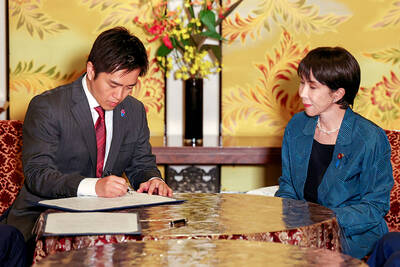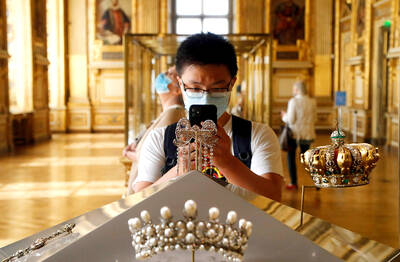Rescue workers set up equipment and prepared yesterday to mount an operation to try to find survivors among 153 trapped miners in a northern China, saying they have not given up hope one week after the mine flooded.
However, no decisions have been made yet on a next step after a dive team entered the mine on Saturday and called the situation underground “very difficult,” with black, murky water complicating efforts to reach sites where rescuers hope miners have survived.
No further signs of life have been detected after apparent tapping was heard on Friday, said Wen Changjin, an official with the news center set up at the mine in the northern province of Shanxi.
Wen said the next step in the rescue plan had not been decided.
Four rescue teams of about 10 people each received a briefing from provincial Governor Wang Jun, who went over a map with them and told them communication was important.
“We are waiting further instructions,” said one of the team leaders, Song Danin. “We will go as far and as deep as we can.”
The area around the shaft entrance of the Wangjialing mine was cleared of debris and pipes, in apparent preparation for a rescue operation.
It is not known how much water is still in the mine. About 3,000 people have been working around the clock to pump out water that poured in when miners digging tunnels broke into an abandoned shaft on March 28.
“All this material is meant for rescuing the people stuck underground. The blankets will cover them when they come out because they will be very cold,” said rescue worker Wei Yandong, sitting near carts full of foldable stretchers and blankets. “There are people down there and some of them must still be alive.”
Experts said the work to reach the miners could last days and their survival depended on decent air to breathe and clean water to drink.
Television footage on Friday afternoon showed rescuers tapping on pipes with a wrench, then cheering and jumping after hearing a response — the first sign of life since the mine flooded. They lowered pens and paper, along with packs containing glucose and milk, down metal pipes into the mine.
However, nothing has been heard since then, Wen said.
The 153 workers were believed to be trapped on nine platforms in the mine, which was flooded with equal to more than 55 Olympic swimming pools, state media have said. Rescuers said four platforms were not totally submerged.
About two dozen ambulances were parked on the road leading into the mine site, and doctors and nurses in white coats stood by.
“The main thing we are prepared to treat is exhaustion because they have been trapped for so long with no support or nutrition, no sunlight, air or water,” said He Xiuming, part of a medical team of about two dozen sent from a nearby hospital. “I think we should still believe in the miracle of life. We have seen it in the Sichuan earthquake, the Indonesian tsunami, so we should try to be positive.”
A preliminary investigation found that the mine’s managers ignored water leaks from the abandoned mine before the accident, the State Administration of Work Safety said.
China’s coal mines are the world’s deadliest. Accidents killed 2,631 coal miners in China last year, down from 6,995 deaths in 2002, the most dangerous year on record, according to the State Administration of Coal Mine Safety.

Indonesia was to sign an agreement to repatriate two British nationals, including a grandmother languishing on death row for drug-related crimes, an Indonesian government source said yesterday. “The practical arrangement will be signed today. The transfer will be done immediately after the technical side of the transfer is agreed,” the source said, identifying Lindsay Sandiford and 35-year-old Shahab Shahabadi as the people being transferred. Sandiford, a grandmother, was sentenced to death on the island of Bali in 2013 after she was convicted of trafficking drugs. Customs officers found cocaine worth an estimated US$2.14 million hidden in a false bottom in Sandiford’s suitcase when

CAUSE UNKNOWN: Weather and runway conditions were suitable for flight operations at the time of the accident, and no distress signal was sent, authorities said A cargo aircraft skidded off the runway into the sea at Hong Kong International Airport early yesterday, killing two ground crew in a patrol car, in one of the worst accidents in the airport’s 27-year history. The incident occurred at about 3:50am, when the plane is suspected to have lost control upon landing, veering off the runway and crashing through a fence, the Airport Authority Hong Kong said. The jet hit a security patrol car on the perimeter road outside the runway zone, which then fell into the water, it said in a statement. The four crew members on the plane, which

Japan’s ruling Liberal Democratic Party (LDP) and its junior partner yesterday signed a coalition deal, paving the way for Sanae Takaichi to become the nation’s first female prime minister. The 11th-hour agreement with the Japan Innovation Party (JIP) came just a day before the lower house was due to vote on Takaichi’s appointment as the fifth prime minister in as many years. If she wins, she will take office the same day. “I’m very much looking forward to working with you on efforts to make Japan’s economy stronger, and to reshape Japan as a country that can be responsible for future generations,”

SEVEN-MINUTE HEIST: The masked thieves stole nine pieces of 19th-century jewelry, including a crown, which they dropped and damaged as they made their escape The hunt was on yesterday for the band of thieves who stole eight priceless royal pieces of jewelry from the Louvre Museum in the heart of Paris in broad daylight. Officials said a team of 60 investigators was working on the theory that the raid was planned and executed by an organized crime group. The heist reignited a row over a lack of security in France’s museums, with French Minister of Justice yesterday admitting to security flaws in protecting the Louvre. “What is certain is that we have failed, since people were able to park a furniture hoist in the middle of